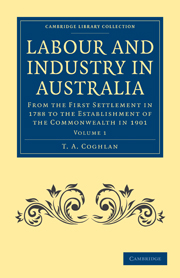 Labour and Industry in Australia
Labour and Industry in Australia Book contents
- Frontmatter
- PREFACE
- Contents
- PART I FROM THE FOUNDATION OF SETTLEMENT TO THE CROSSING OF THE MOUNTAINS
- PART II FROM THE CROSSING OF THE MOUNTAINS TO THE ABOLITION OF THE ASSIGNMENT SYSTEM
- I INTRODUCTION TO THE SECOND PERIOD
- II CONVICT LABOUR: ASSIGNMENT
- III FREE LABOUR
- IV IMMIGRATION
- V THE OCCUPATION OF LAND
- VI AGRICULTURAL AND PASTORAL PURSUITS
- VII THE CURRENCY
- VIII TRADE AND PRICES
- PART III FROM THE ABOLITION OF THE ASSIGNMENT SYSTEM TO THE DISCOVERY OF GOLD
- PART IV FROM THE DISCOVERY OF GOLD TO THE INTRODUCTION OF FREE SELECTION OF LAND BEFORE SURVEY
I - INTRODUCTION TO THE SECOND PERIOD
Published online by Cambridge University Press: 05 August 2011
- Frontmatter
- PREFACE
- Contents
- PART I FROM THE FOUNDATION OF SETTLEMENT TO THE CROSSING OF THE MOUNTAINS
- PART II FROM THE CROSSING OF THE MOUNTAINS TO THE ABOLITION OF THE ASSIGNMENT SYSTEM
- I INTRODUCTION TO THE SECOND PERIOD
- II CONVICT LABOUR: ASSIGNMENT
- III FREE LABOUR
- IV IMMIGRATION
- V THE OCCUPATION OF LAND
- VI AGRICULTURAL AND PASTORAL PURSUITS
- VII THE CURRENCY
- VIII TRADE AND PRICES
- PART III FROM THE ABOLITION OF THE ASSIGNMENT SYSTEM TO THE DISCOVERY OF GOLD
- PART IV FROM THE DISCOVERY OF GOLD TO THE INTRODUCTION OF FREE SELECTION OF LAND BEFORE SURVEY
Summary
The important results of the explorations made under Macquarie have already been alluded to, and when the character of the country in the interior and the limitless possibilities opening out for settlement began to be understood, it was realized also that Sydney was destined to be a great commercial port and that New South Wales could not much longer be used chiefly as a receptacle for convicts. It became necessary, therefore, to find some other place or places that would serve as convict depots, having the essential qualifications which Sydney had now lost, of being remote from the commercial routes and otherwise difficult of access. In October 1823, Sir Thomas Brisbane, who had succeeded Macquarie as Governor-General, acting upon instructions from England, despatched his Surveyor-General, John Oxley, in the cutter Mermaid, to examine and report upon the suitability of the shores of Moreton Bay, Port Curtis, and Port Bowen as sites for a settlement. Oxley first examined Port Curtis, which was most in favour as the site for the new colony, but deeming it unsuitable he turned south and examined Moreton Bay, discovering a fine river emptying itself into the bay at its southern extremity; to this river he gave the name of Brisbane in honour of the Governor. In September of the following year, Oxley was sent back with some soldiers and prisoners to prepare the way for a penal settlement.
- Type
- Chapter
- Information
- Labour and Industry in AustraliaFrom the First Settlement in 1788 to the Establishment of the Commonwealth in 1901, pp. 155 - 172Publisher: Cambridge University PressPrint publication year: 2011First published in: 1918


